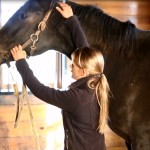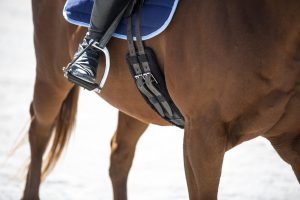Having the ability to ask your horse to lower their head, and have them easily respond, will make many tasks easier and safer – whether it is to put on a halter or bridle, clip a bridlepath, or even medicate an ear or eye. Being willing to lower their head when asked is important for almost any horse (especially tall ones) and it is essential for anyone handling horses to know how to train and then ask for this simple behavior from their horse.
In today’s video I work with a mare named Fiona – she is quite tall and would prefer not to have her head messed with, but after about 8 minutes she is learning to lower her head calmly and willingly.
Fiona shows several of the behaviors that are typical when teaching this, so I think you will enjoy watching her and will be able to easily relate this to your own horse.
I just want to reiterate that there are several ways to teach the behavior of “lower your head.” You can use pressure and release without any food, some horses respond quickly and others may not mind your hand and may just stand there without the extra incentive of a food reward to help “figure it out.” If your horse seems to get stuck and isn’t responding, you can also use a target to help encourage them to lower their head (if they have worked with a target before).
Now try this with your horse and then leave a comment!















26 Responses
THANK YOU!! This is a fabulous suggestion. Ground work is the foundation to a successful partnership with our horse. I would love to see more teaching ‘manners’ videos; for instance, how to train a horse to align and stand still at the mounting block. After years of no problem at the mounting block, my horse has decided to turn her hind end away from the mounting block. Any suggestions? Thanks,
Hi Cheryl – that is a great suggestion for a video and I will make one on this topic in the next few weeks. Until then a quick and easy suggestion is to place your mounting block so that your horse comes between the block and a fence or a jump, even a pole on the ground, to discourage swinging the hindquarters out. Set up the right behavior and reward it, then slowly increase the distance between the block and the “barrier.”
Please post more videos with Fiona! I’m taking lessons with a horse that moves around a lot in the cross ties and it really helps to see how you manage a horse when training, even when you aren’t explaining to the camera what you are doing. I noticed there was one point where she turned her head away and rather than pulling her lead rope so her head was back to center, you just waited for her head to come back. I would have pulled or shook the lead rope. Maybe I need to be more patient.
Hi Eveyln,
Glad you enjoyed the video! With a horse like Fiona, who is a bit fidgety, especially in a stall away from her friends, I find that it is best to give them some freedom to look around and then choose when to come back for more interaction and training. It’s basically like allowing them to take a mental break. Works very well with positive reinforcement because they usually want to come back!
Thanks Callie. This video has been so helpful. Rinconerro is a big boy standing at 16 hands and I’m quite small. Just as well he’s so clever and very kind.
Wonderful way to keep instructions simple and precise! My husband doesn’t ride but he loves our horses and this is a way that will help both of us bond with our young horse and be consistent with our older mare! Keep using Folona…she is a great visual for what most of us experience!
that horse reminds me of mine!thank you for that…i use poll pressure…which one do u think would be better?Sometimes my horse just keeps her head up,she’s taller than me and so my arm gets tired fast.What can i do about that?Would that be because I’m using poll pressure and she’s getting used to it?
Hi Kimberly,
That is exactly why I started using treats when teaching head down. I found that some horses really didn’t care that much that my hand was up there, and I would get tired and frustrated before they would ever lower their head. When you are working with food the horse will generally “want” to find the right answer more quickly – and you can just leave your hand soft instead of trying to apply more pressure to motivate them to start “trying things”. As I mentioned in the post, I will also sometimes use a target to get them lowering their head if they get stuck as well.
Thank you again callie another great informative video. Such simple lessons on head lowereing can be so effective. Look forward to seeing fiona again in furure videos and how your great work brings out the best in her. Regards jackie x
Thanks for sharing. I love to see trainers advocating positive reinforcement and glad to have found your blog.
Hi Rebecca,
Looks like you have a great blog as well! Thanks for taking the time to watch my video and comment!
so nice to see your positive reinforcement videos. Would love you to check out my site too! great to have more good trasining going on out there and great videos too.
My horse is 6 months old, and he wasn’t handled much before I got him. Now I am trying to make up for lost time. He accepts petting on his body, but not on his head. This week I began a more persistent training of trying to pet his head, on the poll, the cheek, the nose. He allows this while he is eating, (well, he doesn’t like my touching his nose at all) but not when he’s just standing. Should I not be trying while he’s eating? In other words, I don’t have his full attention while he’s eating, therefore is he not really learning to accept my touching his head?
Thanks for your help, Pam
Hi Pam,
I think what you are doing now – petting him while he is eating – is just fine. That can actually be a form of counter conditioning, where you use something good (the food) to help change an individual’s assocations of something (being petted).
I see you’ve read Karen Pryors book..great book. You might want to check out Alexandra Kurland’s books on clicker training for horses..a great resource from someone classically trained and using positive reinforcement.!
Thanks! I have watched some of Alex’s videos – that is where I learned to take the halter before giving the treat – but I need to check out her books too!
I started doing this with Izzy and she responds REALLY well. I love that you used it on a horse that had zero experience in it. It helps to see reactions from you as well as the horse. That way I know how to react to similar behaviors such as pulling at your shirt etc. I don’t want to have too much reaction to small behaviors.
It was great to see the progress in such a short time in getting Fiona to lower her head. It would be good to see the same when you’re putting on the bridle. My experience has been that the horse may be fine with head position when the halter is on but raise their head when I’m trying to bridle and be quite resistant to lowering it. This is harder to do when you need your two hands for the bridle. Thanks!
Hi, I have a young mare who was very head shy when I first got her 6 months ago but has improved with perseverance and patience. She is particularly sensitive about her ears so I tried your lower head technique placing my hand at the top of her neck with my index finger just touching the base of her ear. At first not happy but one packet of mints later….. She was chilled and very happy me touching her neck and her ear. Will do this again but would welcome some advice on clipper training. She is fine with the sound and feel of the clippers until the blade touches the hair and then she freaks out. ….dangerously so!!!! Any advice gratefully received . Love watching your videos ….thank you!
Hi Callie!
This is a wonderful video! Thanks so much for sharing it! I have a question though… I adopted a 3 year old paint/draft gelding last summer. The trainer told me he was “a little mouthy” when I got him. He wasn’t kidding! I try to stay as far away from his mouth as possible so treats are not a good option for him. While I certainly don’t want to make him head shy I am looking for suggestions to discourage his mouthy behavior. He has also learned to just lift his head taller than the person working with him as he is 16+ hands tall. I have been trying to get him to lower his head respectfully but often times he tries to grab my shirt (on my left arm) as I am keeping my right hand on his poll. He is very quick! Any suggestions that you can give me would be much appreciated. I would love to see a video on working with “mouthy” horses!
I forgot to mention he was an orphan colt so he was a bottle fed baby.
Hi Diane, I just posted a video on mouthy horses! Here is the link: https://crktrainingblog.com/tips-for-handling-mouthy-biting-horses/
I tried this training tip for the first time tonight. It only took a few times before he “Got it”. Can’t thank you enough!!
Great Denise! Glad it was helpful!
Hi Callie please could you answer this question. My friend tells me off for giving treats to his horse that I ride. I give him a mint when I go riding but he says it teaches them to nip. Is this true and should I stop.
Loving the videos THANK YOU
ADRIAN
Hi Adrian,
Feeding treats will only teach nipping if you are rewarding nipping, meaning feeding the treat as the horse nibbles your clothing or hand. If you teach the horse to keep his head away as you are getting the treat out and until you give it to him you can prevent behaviors such as nipping.